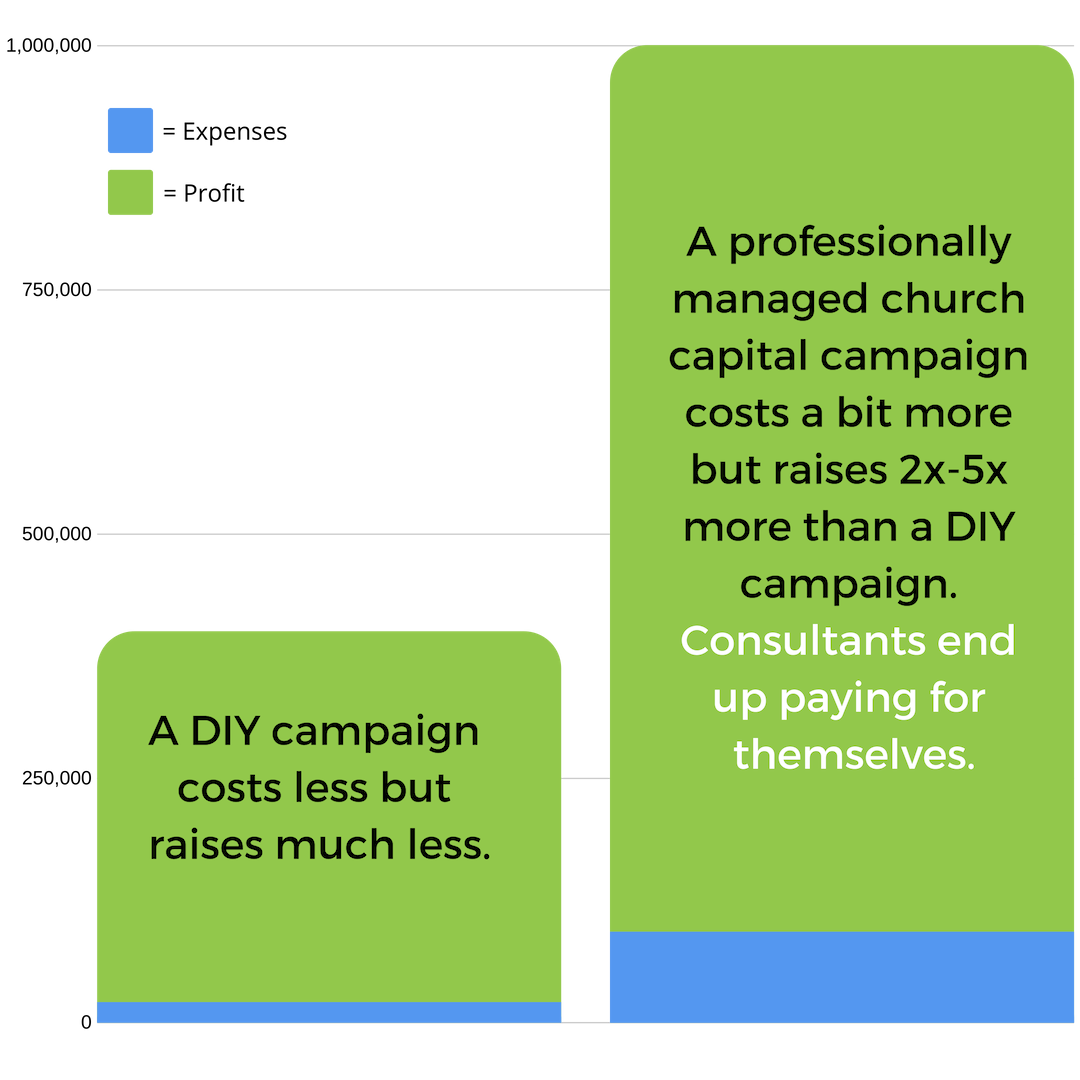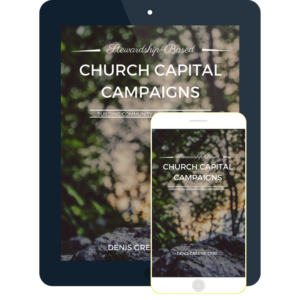The sticker shock of professional church capital campaign consulting proposals can be paralyzing. Often the church leaders’ response is to move forward with a capital campaign without assistance – we call this the do-it-yourself, or DIY campaign. Self-run campaigns can be enticing on the surface because it seems that the church can save upwards of six figures on consulting fees. However, this thinking is short sighted and can cost the church greatly in multiple domains. Here we lay out the hidden costs of a DIY church capital campaign.
They are:
- Capital Campaign Profit
- Annual Giving Income
- Staff Resources
- Ministry Opportunity Cost
- Objectivity & Community Rapport
- Precious Time
1. DIY church capital campaigns raise (a lot) less
The numbers speak for themselves. Church capital campaigns run without a professional consultant raise, on average, 50-100% of annual giving. The professional average is 250% of annual giving. That is why most denominational, regional, and diocesan leaders recommend hiring a professional. Why do professionals raise so much more? That’s a wonderfully complex question.
There are a lot of factors that go into why church fundraising firms are successful above and beyond staff and volunteer-run projects. Some of them include:
- Consultants’ professional training on best-practices in organizational development
- Experience in identifying and cultivating leadership donors
- A process-oriented approach that builds on psychology research
- Centralized campaign organization with a designated point person charged with preventing project stagnation
- Objective perspective that facilitates rational decision-making
- Strategic plan for campaign follow up
Professional firms’ fees vary depending on the type of service they provide (strategy only vs. comprehensive capital campaign management), the experience level of the firm, and size of the project. It’s not unusual for a consultant fee to exceed $100,000. This seems like a ton of money out of pocket – and it is! Pastors, rectors, parish priests, and lay leaders are understandably worried about being good stewardship of the financial gifts given to the church. But let’s look at the numbers.

Above is a side by side comparison of expenses and profits of a DIY vs. a professional church capital campaign. This example is a church with $400,000 in undesignated annual giving. A DIY campaign would raise about 100% annual giving, so $400,000. Costs would be about $21,000. We calculated costs for this 400 family church to be $15 per family for campaign materials and events ($6,000), and about $15,000 (700 hours) of a staff person’s time dedicated to the campaign (we’ll discuss this more below) for a total expenditure of $21,000. Profit ends up being $379,000. Not a bad chunk of money.
Let’s look at the same church if they chose to run their capital building project with a fundraising consulting firm. Expenditure on materials and events would be the same $15/family or $6,000. Staff time would be significantly less at about $2,000 (100 hours). Hiring Church Development for your campaign management might cost you $85,000 for comprehensive service. Your expenses work out to be $93,000. “That is almost $72,000 more than the cost of a DIY campaign!”, you say. Yes, BUT because professional campaigns statistically raise more by percentage of annual giving, your profit on the campaign ends up being $907,000! A much more profitable capital campaign.
That’s a profit difference of over half a million dollars ($528,000 to be exact).
I guarantee, that’s the best $70,000 you ever spent. The ROI, or return on investment, of professional firms cannot be ignored. Remember the parable of the talents in the Gospel of Matthew 25: 20-21
“And he who had received the five talents came forward, bringing five talents more, saying, ‘Master, you delivered to me five talents; here I have made five talents more.’ His master said to him, ‘Well done, good and faithful servant; you have been faithful over a little, I will set you over much; enter into the joy of your master.’”
2. Annual giving can suffer
Literally a hidden financial cost of a DIY church capital campaign. A huge fear of many finance, building, and capital campaign committees is that a fundraising effort will cause a decrease in annual giving, which is the pool that funds necessary ministries and utility/building expenses. The belief behind this fear is that people are already stretched in their financial giving/tithing to the church, and the funds they have set aside will not increase, they will simply be split differently.
There is always a risk for this happening. DIY campaigns can be especially at risk because they often involve simply producing some marketing materials and sending them out with a pledge card. (There are companies out there, we won’t name them, that will let you buy a capital campaign kit to do just this – but the effect on annual giving is disastrous!) Please do not fall into this trap. What significantly mediates the decrease in annual gifts is a capital campaign built around prayer, member engagement, shared-decision making, and stewardship education. These types of campaigns are a lot of work (see #3 below), but they make all the difference.
We have spent the past 30 years developing and tailoring our stewardship-based capital campaign process and have implemented it in hundreds of churches, tailoring each campaign to fit the needs of the parish or congregation. As a result, we actually have have a track record of increasing annual giving by 10% per year in the wake of a capital campaign. This is because we engage people in making an thoughtful decision about stewardship.
We did this at 3 churches recently, Hamilton Mills Presbyterian (22% increase in annual giving), St. Margaret of Scotland (15% increase in annual giving), and Batavia United Methodist (10% increase in annual giving).

Let’s run some numbers again – if your annual giving is $400,000, a 10% increase the first year would equal $40,000. The second year, a 10% increase would equal $44,000. The third year, a 10% increase would equal $48,400. By the end of the third year, your annual giving has gone up to $532,400. Again, your consultants have paid for themselves.
3. Staff resources are stretched
You pay your church administrator X dollars per year… if you choose to run your own church capital campaign, plan for 1/3 – 1/2 of that person’s time (and salary) to go toward capital campaign expenditure. That could be a lot of money, $10k – $30k or more.
Where did I come up with that estimation? Managing a successful capital campaign calls for, conservatively, 700 hours of professional staff time. Here is a breakdown of where the time goes:
Feasibility Study – 100 hours
- Interview 60 people
- Mail personalized letter and custom survey to hundreds of others
- Data input from survey results
- Accurate, predictive data analysis
- Presentation to leadership committee and church members
Communication – 100 hours
- Church capital campaign marketing materials
- Brochure writing & design
- Campaign update newsletters
- Website
- Email newsletters/campaign promotion
- Bulletin information
- Social media campaign marketing
- Promotional video production
Managing 100+ Volunteers – 200 hours
- Constant communication with leaders of Prayer, Event, Thanks, Youth, Ambassador and Communication committees
Management Team details – 200 hours
- Weekly meetings
- Capital campaign budget oversight
- Calendar management and updates
- Final campaign publications approval and publishing
- Detailed follow through on campaign logistics
Leadership – 100 hours
- Over site of campaign strategy
- Guidance for pastor and team leaders
- Consulting on road bumps or unusual challenges
- Nurturing top donors
- Involving the Steering Committee in decision-making

It’s an oversight not to calculate this staff time as a cost in the capital campaign expenditure. You might be able to make a claim that you were going to spend this money already, so it’s not added expenditure, but there are 3 possible scenarios of putting the campaign project management on your staff’s shoulders:
- The capital campaign process is compromised as it is squeezed into available minutes here and there for already over-burdened staff schedules.
- The capital campaign is given due diligence but there is a decrease in time available for already assigned critical tasks/ministries (see below).
- Neither the capital campaign nor the ministry is compromised but there is an increase in working hours required to get everything accomplished (a sure way to become an instant enemy of your personnel)
While it can be exciting to dip your hands into a new field (fundraising, graphic design, copy-writing), these tasks all take time to learn, even with technologies in place that support those who are inexperienced. A task that takes an experienced capital campaign consultant an hour could take a first-timer 2-3 hours. Have a printing mail-merge mistake? That could easily cost a $1,000 in reprinting. Calculate these costs into your actual DIY campaign budget and you’ll see it is not as inexpensive as you thought.
(Additionally, there is often a lot of pressure on capital campaigns to succeed. For an inexperienced staff person, this can be very stressful.)
4. Ministry opportunities are lost
One thing that I haven’t seen mentioned in other analyses of whether or not to hire a professional campaign consultant firm, is a term most commonly used in the investments and economics world: opportunity cost. This phrase refers to the loss of potential gain when one alternative is chosen over another. Usually this is discussed regarding finances (and you can see from #1 on this list that the financial opportunity costs of a DIY campaign are high), but more importantly this is also a reality for ministry.
Chances are you hired your pastoral staff because of their extraordinary ability to grow ministries and invite members into a deeper relationship with Christ. How much are they able to realize their potential for outreach and evagenlization when they are working half of their time on a project that is outside of their training and wheelhouse? This as a major oversight in choosing to do a DIY church capital campaign. Don’t get distracted from your God-given vision. Save staff time and headache while maximizing their spiritual leadership potential by contacting a professional capital campaign consultant.
5. Objectivity and community rapport take a hit
You know when you’ve been staring at something for too long that you can’t see it clearly anymore? This is your church in a DIY campaign project. The objectivity that outside consultants bring to a project is invaluable in avoiding some major mistakes. There are often tricky decisions that need to be made in a campaign process. Consultants can help bring you out of the murky waters of your attachments to and fears of certain outcomes. We help you establish reasonable expectations and goals. When you are hiring a fundraising consultant, you are paying for objectivity and peace of mind.
Even with this objective perspective, there are always going to be some disgruntled parishioners. An outside firm managing your stewardship effort can serve as a barrier island in the hurricane, taking the worst hits and criticism instead of the church leadership. We take the blame for any dissatisfaction with decisions that were made (although we try to consider everyone’s opinion, you can’t please everyone all the time). We tell our clients we’ll happily take the heat of disgruntled congregants – tell them we advised you to do it! It’s a dirty job, but someone has to do it. In a DIY campaign, you are on your own.
6. Precious time ticks by while no one is in charge
Finally, without a dedicated person in charge of pushing the boulder up the hill, a capital building, renovation or deferred maintenance project can drag on for a decade. Committee work is important to build consensus, but a single person with concentrated responsibility is the key to stewardship success and is invaluable in moving the campaign along on a timeline. Without a point-person, weeks can go by as everyone puts the campaign on the back burner in lieu of more seemingly urgent projects. All of a sudden, your congregation’s excitement from the feasibility study has waned. What a waste!
The job of a campaign consultant is to keep the project in the forefront of the minds of the people who really matter – the church leadership and volunteer committee members. These are the VIP, tailoring the campaign prayer and creating social events for their fellow pew-sitters. But everyone knows how committees work… See these cats? You’re going to be the one in charge of herding them in a DIY church capital campaign. No thanks! Hire the professional.

Still skeptical? Don’t take our word for it. Here are denominational leaders that agree with us that hiring a professional, well-rounded capital campaign team will be in your best interest.
- Diocese of Austin, TX
- Archdiocese of St. Paul and Minneapolis
- Episcopal Church in Colorado
- Presbyterian Foundation
If you want more information about what goes into running a church capital campaign, we’ve written up all our year of experience into a convenient eBook that will give you all the education yo need to get started.
Download eBook on Church Capital Campaigns


